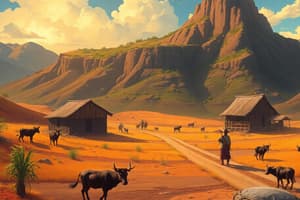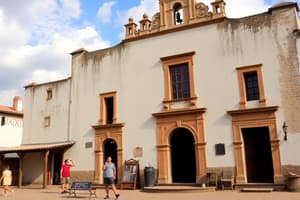Podcast
Questions and Answers
What was one of the main reasons Native Americans suffered during the early period of slavery in the Americas?
What was one of the main reasons Native Americans suffered during the early period of slavery in the Americas?
- Forced relocation to different regions
- High mortality rates from disease and starvation (correct)
- Overpopulation in their original settlements
- Loss of their traditional agricultural practices
What was a significant labor requirement for enslaved Africans in the Americas?
What was a significant labor requirement for enslaved Africans in the Americas?
- Farming cash crops such as sugar (correct)
- Crafting tools and weapons
- Building infrastructure in cities
- Manufacturing textiles
In which colony were many enslaved Africans primarily utilized for their labor in sugar production?
In which colony were many enslaved Africans primarily utilized for their labor in sugar production?
- Portuguese Brazil (correct)
- French Louisiana
- New England
- Spanish Florida
What was a common consequence faced by those who were enslaved in the Americas?
What was a common consequence faced by those who were enslaved in the Americas?
What term best describes the forced migration and labor conditions experienced by Africans during this period?
What term best describes the forced migration and labor conditions experienced by Africans during this period?
What significant realization did Spain come to regarding their claims in the Americas?
What significant realization did Spain come to regarding their claims in the Americas?
What was the main purpose of establishing the colonies in New Spain?
What was the main purpose of establishing the colonies in New Spain?
Which area did the colony of New Spain primarily encompass?
Which area did the colony of New Spain primarily encompass?
What actions did Spain take to mitigate threats to its territorial claims?
What actions did Spain take to mitigate threats to its territorial claims?
What misconception did many European nations have regarding land claims in the Americas?
What misconception did many European nations have regarding land claims in the Americas?
What aspect of European claims to land in the Americas was largely ignored?
What aspect of European claims to land in the Americas was largely ignored?
Which city served as the capital of New Spain?
Which city served as the capital of New Spain?
What was one reason that increased European colonization in the Americas?
What was one reason that increased European colonization in the Americas?
Which group faced significant mortality due to diseases brought by European settlers?
Which group faced significant mortality due to diseases brought by European settlers?
Who was Bartolome de Las Casas and what was his significant contribution?
Who was Bartolome de Las Casas and what was his significant contribution?
What primary labor need drove the colonists to begin capturing Africans?
What primary labor need drove the colonists to begin capturing Africans?
In which geographic region were most enslaved Africans taken during this period?
In which geographic region were most enslaved Africans taken during this period?
What was a major consequence of the colonization efforts in the Americas?
What was a major consequence of the colonization efforts in the Americas?
How did the introduction of slavery impact the economy of the colonies?
How did the introduction of slavery impact the economy of the colonies?
What was a justification used by Europeans for the capture of enslaved Africans?
What was a justification used by Europeans for the capture of enslaved Africans?
What type of farms were primarily established in the Americas that influenced the development of slavery?
What type of farms were primarily established in the Americas that influenced the development of slavery?
What role did gold and silver play in the expansion of European colonies in the Americas?
What role did gold and silver play in the expansion of European colonies in the Americas?
Flashcards
Enslaved Africans in Americas
Enslaved Africans in Americas
Africans forcibly brought to the Americas and made to work without pay under harsh conditions.
Native American deaths
Native American deaths
Thousands of Native Americans died due to starvation and the work they performed.
Sugar mills in Brazil
Sugar mills in Brazil
Enslaved Africans were forced to work in sugar mills in the Portuguese colony of Brazil.
New Spain
New Spain
Signup and view all the flashcards
Slavery in the Americas
Slavery in the Americas
Signup and view all the flashcards
European Colonization
European Colonization
Signup and view all the flashcards
European Competition
European Competition
Signup and view all the flashcards
Spanish Claims
Spanish Claims
Signup and view all the flashcards
Plantations
Plantations
Signup and view all the flashcards
Native American presence
Native American presence
Signup and view all the flashcards
Bartolome de Las Casas
Bartolome de Las Casas
Signup and view all the flashcards
Native American deaths
Native American deaths
Signup and view all the flashcards
Spanish colonies
Spanish colonies
Signup and view all the flashcards
Forts in North America
Forts in North America
Signup and view all the flashcards
African Enslavement
African Enslavement
Signup and view all the flashcards
Study Notes
New Spain
- By the 1500s, several European nations, including Spain, sent explorers to claim land in the Americas.
- Explorers often claimed hundreds of miles of land after stepping onto a beach.
- They did not stay to protect the claims.
- European countries competed to control as much land as possible.
- Native Americans already lived in most of the claimed lands, but their rights were often ignored.
- Spain claimed large parts of the Americas.
- Spain realized claiming land was not the same as controlling it and needed to protect its land from other European nations.
- Spain formed colonies to protect its land and govern the people.
- The colony of New Spain was formed in 1535, mostly in Mexico with Mexico City as its capital.
- New Spain also included many islands in the Caribbean Sea and Spanish lands north of present-day Panama.
- Spain built forts to protect its claims in North America.
Slavery in the Americas
- Initially, very few Europeans settled in the Americas.
- More colonists came when gold and silver were discovered.
- Colonists created large farms called plantations.
- By 1550, there were about 100,000 Spanish colonists in the Americas.
- Portugal formed the colony of Brazil to the South of New Spain.
- Both Spain and Portugal needed many workers for farming and mining.
- They forced Native Americans into slavery.
- Thousands of Native Americans died from hunger and the work they did, and other diseases brought from Europe.
- Some colonists became concerned about the treatment of Native Americans. One such person was Bartolomé de Las Casas.
- Las Casas freed his enslaved workers and spoke out in favor of better treatment for Native Americans.
- As Native American populations declined, colonists began enslaving Africans.
- Many Africans were taken to Brazil and the Caribbean Islands.
- Enslaved Africans also worked in terrible conditions in sugar mills in Brazil.
Settlements of New Spain, 1650
- Spain wanted to protect the lands north of Mexico City.
- These lands on the edge of Spain's claims were called borderlands.
- The borderlands included parts of present-day northern Mexico and the southern United States, from Florida to California.
- Spain built the first permanent European settlement in what is now the US, in St. Augustine, Florida in 1565.
- Spanish soldiers built presidios (forts) in the borderlands.
- Spain established missions, which were religious settlements, in areas of the southern half of North America.
- Missionaries helped settle Santa Fe, the capital of the New Mexico colony.
- Missions were locations where missionaries and Native Americans resided near each other.
Life in the Borderlands
- Some Native Americans chose to stay in missions and learn new ways of living and working.
- Others were forced to work on mission farms and ranches.
- Some people resisted by tearing down churches and mission buildings.
- The Spanish brought cattle and sheep and horses to the land; these heavily impacted indigenous life.
- Some Native Americans learned how to tame horses for use in hunting and war.
- Some learned to raise sheep and use wool for clothing.
England Attempts a Colony
- England wanted colonies in the Americas to gain resources like lumber.
- Raw materials could be used to make products.
- In 1584, Queen Elizabeth I chose Walter Raleigh to establish a colony.
- Raleigh sent colonists to Roanoke Island (part of present-day North Carolina).
- These colonists did not stay long.
- The colonists ran low on supplies and returned to England.
- In 1587, John White led another group of settlers to Roanoke Island, seeking additional resources.
- White returned three years later and found that all of the settlers had disappeared, calling this the Lost Colony.
- In the early 1600s, English merchants formed the Virginia Company and established a colony in Virginia to try and establish a profitable colony.
- Companies sold stock (part ownership) to the public
Jamestown
- In 1607, three ships from the Virginia Company sailed into the Chesapeake bay, establishing Jamestown.
- The colonists built a settlement on the James River in honor of King James I.
- Jamestown was a poor location for a settlement.
- The land wasn't good for farming.
- Colonists had little interest in farming and focused on finding gold instead.
- More than half of the colonists died in the first year.
- John Smith helped Jamestown survive.
- He established a "work or starve" rule for the colony.
- Tobacco crops were grown – a very important cash crop in the colony.
Growth and Government
- Growing tobacco required many workers.
- The Virginia Company paid for people to travel to Virginia in exchange for work.
- These workers were called indentured servants.
- Indentured servants worked from 4-7 years without pay.
- In 1619, the first Africans were brought to Jamestown.
- No one knows if they were indentured servants or enslaved people.
- Over time, more Africans arrived as enslaved people.
- Enslaved labor significantly contributed to the prosperity of the colony.
- Virginia needed more laws to maintain order and peace.
- The colonists established a legislature called the House of Burgesses in 1619.
The Powhatan Confederacy
- Most of the Native Americans in Virginia were part of the Powhatan Confederacy.
- Colonists took over Powhatan land as the colony grew, leading to conflicts.
- Years of fighting between the Powhatan and the colonists are known as the Powhatan Wars.
- In 1624, King James I made Virginia a royal colony, meaning the king controlled the colony.
- A governor was appointed to help run the colony, sharing power with the House of Burgesses.
Studying That Suits You
Use AI to generate personalized quizzes and flashcards to suit your learning preferences.




